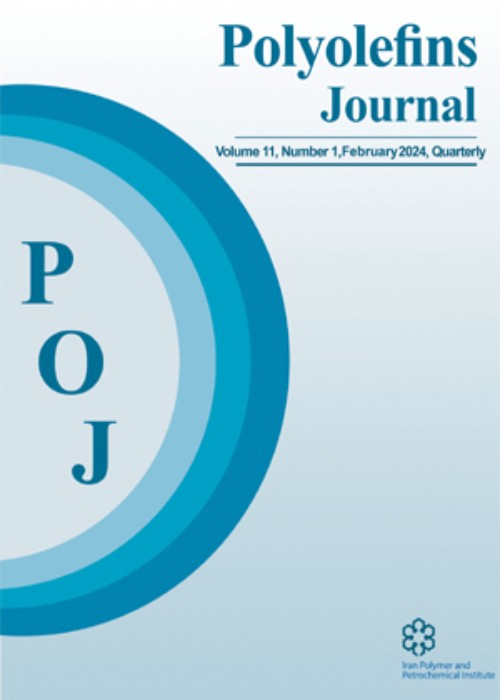Compatibilization of polycarbonate/poly (ethylene terephthalate) blends by addition of their transesterification product
Author(s):
Article Type:
Research/Original Article (دارای رتبه معتبر)
Abstract:
In this study, poly carbonate (PC) and poly (ethylene terephthalate) (PET) were reactive melt-blended under two different conditions to produce PC/PET copolymers. For each condition, samples were taken at specified mixing times representative a specific structure of copolymers and each one employed to physically compatibilize a PC/PET blend with a fixed composition. Reactive blending and copolymer structure are described by solubility analysis results. Continues declining and going through a minimum are two trends of solubility versus mixing time depending on reactive blending condition. Decreasing and increasing patterns of solubility curves were attributed to the formation of copolymers with longer and shorter block lengths, respectively, and the level of solubility was related to the amount of produced copolymers. Differential scanning calorimetry (DSC) and scanning electron microscopy (SEM) techniques were employed to investigate blend compatibility. The content and structure of copolymers showed favorable correlation of Tg differences of blend components and PET crystallinity. As expected, Tg of blend components approached to each other by the addition of copolymers, and the copolymers with longer block length caused less Tg differences. The melting point and crystallinity of PET were affected by introducing the copolymers too. In addition to the main melting endotherm, melting endotherm peaks of compatibilized blends had a shoulder that its corresponding melting point and crystallinity are related to the copolymer structure so that the longer length of block copolymer or higher its amount leads to the higher melting points. The SEM micrographs showed that, after the addition of the copolymer, smaller PET particles formed and uniformly dispersed in the PC matrix. A strong correlation between the blend morphology and the level of blend compatibility was demonstrated. The more compatibilized PC/PET blend, the better dispersion of PET particles in the PC matrix was obtained. The results of this study could be a basis for designing and production of compatibilizers suitable to achieve a desired level of compatibility in PC and polyester blends, specially in PC/PET blend.
Keywords:
Language:
English
Published:
Polyolefins Journal, Volume:6 Issue: 1, Winter 2019
Pages:
75 to 83
magiran.com/p1918657
دانلود و مطالعه متن این مقاله با یکی از روشهای زیر امکان پذیر است:
اشتراک شخصی
با عضویت و پرداخت آنلاین حق اشتراک یکساله به مبلغ 1,390,000ريال میتوانید 70 عنوان مطلب دانلود کنید!
اشتراک سازمانی
به کتابخانه دانشگاه یا محل کار خود پیشنهاد کنید تا اشتراک سازمانی این پایگاه را برای دسترسی نامحدود همه کاربران به متن مطالب تهیه نمایند!
توجه!
- حق عضویت دریافتی صرف حمایت از نشریات عضو و نگهداری، تکمیل و توسعه مگیران میشود.
- پرداخت حق اشتراک و دانلود مقالات اجازه بازنشر آن در سایر رسانههای چاپی و دیجیتال را به کاربر نمیدهد.
دسترسی سراسری کاربران دانشگاه پیام نور!
اعضای هیئت علمی و دانشجویان دانشگاه پیام نور در سراسر کشور، در صورت ثبت نام با ایمیل دانشگاهی، تا پایان فروردین ماه 1403 به مقالات سایت دسترسی خواهند داشت!
In order to view content subscription is required
Personal subscription
Subscribe magiran.com for 70 € euros via PayPal and download 70 articles during a year.
Organization subscription
Please contact us to subscribe your university or library for unlimited access!


